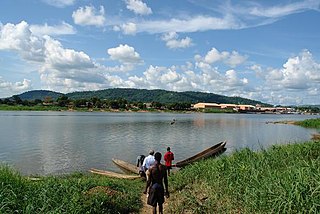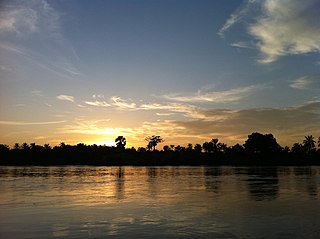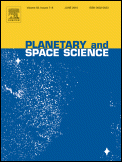
The Ubangi River, also spelled Oubangui, is the largest right-bank tributary of the Congo River in the region of Central Africa. It begins at the confluence of the Mbomou and Uele Rivers and flows west, forming the border between Central African Republic (CAR) and Democratic Republic of the Congo. Subsequently, the Ubangi bends to the southwest and passes through Bangui, the capital of the CAR, after which it flows south – forming the border between Democratic Republic of the Congo and Republic of the Congo. The Ubangi finally joins the Congo River at Liranga.
Image analysis or imagery analysis is the extraction of meaningful information from images; mainly from digital images by means of digital image processing techniques. Image analysis tasks can be as simple as reading bar coded tags or as sophisticated as identifying a person from their face.

The Kasai River is a left bank tributary of the Congo River, located in Central Africa. The river begins in central Angola and flows to the east until it reaches the border between Angola and the Democratic Republic of the Congo, where it turns north and serves as the border until it flows into the DRC. From Ilebo, between the confluences with Lulua river and Sankuru river, the Kasai river turns to a westerly direction. The lower stretch of the river from the confluence with Fimi river, is known as the Kwa(h) River, before it joins the Congo at Kwamouth northeast of Kinshasa. The Kasai basin consists mainly of equatorial rainforest areas, which provide an agricultural land in a region noted for its infertile, sandy soil. It is a tributary of Congo river and diamonds are found in it. Around 60% of diamonds in Belgium go from Kasai river for cutting and shaping.
Geoinformatics is the science and technology that develop and use data, software, and computing facilities in the cyberinfrastructure ecosystem to address the needs of geosciences and related branches of science and engineering.
Geographic information science or geoinformation science is a scientific discipline at the crossroads of computational science, social science, and natural science that studies geographic information, including how it represents phenomena in the real world, how it represents the way humans understand the world, and how it can be captured, organized, and analyzed. It is a sub-field of geography, specifically part of technical geography. It has applications to both physical geography and human geography, although its techniques can be applied to many other fields of study as well as many different industries.

The great gerbil is a large rodent found throughout much of Central Asia.
Earth observation (EO) is the gathering of information about the physical, chemical, and biological systems of the planet Earth. It can be performed via remote-sensing technologies or through direct-contact sensors in ground-based or airborne platforms.
Biotechnology and Applied Biochemistry is a bimonthly peer-reviewed scientific journal covering biotechnology applied to medicine, veterinary medicine, and diagnostics. Topics covered include the expression, extraction, purification, formulation, stability, and characterization of both natural and recombinant biological molecules. It is published by Wiley-Blackwell on behalf of the International Union of Biochemistry and Molecular Biology. The editors-in-chief are Gianfranco Gilardi and Jian-Jiang Zhong.
The Journal of Applied Economics is a peer-reviewed open-access academic journal established in 1998 that covers applied issues in micro- and macroeconomics, including industrial organization, international economics, labor economics, finance, money and banking, growth, public finance, political economy, law and economics, and environmental economics.

Planetary and Space Science (P&SS), published 15 times per year, is a peer-reviewed scientific journal established in 1959. It publishes original research articles along with short communications (letters). The main topic is Solar System processes which encompasses multiple areas of the natural sciences. Numerical simulations of solar system processes are also conducted at ground-based facilities or on-board space platforms. The editor-in-chief is Maria Cristina De Sanctis. It is published by Elsevier.
Advances in Applied Mathematics is a peer-reviewed mathematics journal publishing research on applied mathematics. Its founding editor was Gian-Carlo Rota ; from 1980 to 1999, Joseph P. S. Kung served as managing editor. It is currently published by Elsevier with eight issues per year and edited by Hal Schenck and Catherine Yan.

Language Testing is a quarterly peer-reviewed academic journal covering language testing and assessment. Its editors-in-chief are Luke Harding and Paula Winke. It was established in 1984 and is published by SAGE Publications.
Bulletin of the Seismological Society of America (BSSA) is a bimonthly peer reviewed scientific journal published by the Seismological Society of America. The editor-in-chief is Thomas Pratt. The journal covers seismology and related disciplines. Topical coverage includes theory and observation of seismic waves, specific earthquakes, the structure of the Earth, earthquake sources, hazard and risk estimation, and earthquake engineering. Publishing formats include regular papers and short notes. Publication has been continuous since 1911.
Women's Studies International Forum is a bimonthly peer-reviewed academic journal covering feminist research in the area of women's studies and other disciplines. The journal is published by Elsevier and its editor-in-chief is Kalwant Bhopal.

Discrete Applied Mathematics is a peer-reviewed scientific journal covering algorithmic and applied areas of discrete mathematics. It is published by Elsevier and the editor-in-chief is Endre Boros. The journal was split off from another Elsevier journal, Discrete Mathematics, in 1979, with that journal's founder Peter Ladislaw Hammer as its founding editor-in-chief.

Gaofen is a series of Chinese high-resolution Earth imaging satellites launched as part of the China High-resolution Earth Observation System (CHEOS) program. CHEOS is a state-sponsored, civilian Earth-observation program used for agricultural, disaster, resource, and environmental monitoring. Proposed in 2006 and approved in 2010, the CHEOS program consists of the Gaofen series of space-based satellites, near-space and airborne systems such as airships and UAVs, ground systems that conduct data receipt, processing, calibration, and taskings, and a system of applications that fuse observation data with other sources to produce usable information and knowledge.
Menno-Jan Kraak is a Dutch cartographer and professor of Geovisual Analytics and Cartography at the Faculty of Geoinformation Sciences and Earth Observation at the University of Twente. He is known for his work in cartography and his activities in the International Cartographic Association.

Remote Sensing of Environment is an academic journal of remote sensing published by Elsevier. The journal was established in 1969 by Elsevier. Its editors-in-chief are Jing. M. Chen, Menghua Wang, and Marie Weiss.
The Journal of Photogrammetry, Remote Sensing and Geoinformation Science is an academic journal published by Springer on behalf of the German Society for Photogrammetry, Remote Sensing and Geoinformation about photogrammetry, remote sensing, and geoinformation science. Its editor-in-chief is Markus Gerke. According to the Journal Citation Reports, the journal has a 2020 impact factor of 1.857.
Applied and Computational Harmonic Analysis is a bimonthly peer-reviewed scientific journal published by Elsevier. The journal covers studies on the applied and computational aspects of harmonic analysis. Its editors-in-chief are Ronald Coifman and David Donoho.







